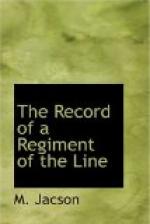At about 3.30 p.m. the news was distributed that General Buller had gained a complete victory over the Boers, who were in full retreat. Hundreds of wagons were seen going off north towards Modder Station and Vanreenens, and at 4 p.m. a derrick was seen hoisted over the big gun on Bulwana, and the naval guns opened fire on him. The Boers dismounted him under a heavy fire from one 4.7 and two naval 12-pounders, and got him away.
At 6.20 p.m. a welcome sight greeted the eyes of the weary garrison, for suddenly out of the bush appeared two squadrons of mounted men, riding leisurely in across the plain from the direction of Intombi, and the truth dawned on the garrison that Ladysmith was at last and in reality relieved.
The siege had lasted four calendar months to the day.
Frantic cheering greeted them as they crossed the ford and reached the town.
On the following day a column, consisting of the Devons, Gordon Highlanders, three batteries of artillery, all the cavalry who had horses, and the two mounted colonial corps, the whole under the command of Colonel W.G. Knox, sallied forth at 10 a.m. towards Modder Station to pursue and to stop the Boers getting their big guns away by train. On arriving abreast of Pepworth Hill, which the Boer rear-guard had occupied, the advanced troops, consisting of Devons and the batteries, came under rather a sharp fire. All further progress was stopped, and the column returned to camp. The Devons had two men wounded. Camp was reached at 4.30 p.m. The battalion was met on the way home by Major Davies, Captains Bols and Vigors, Lieutenants Lafone and Munro, all of the 2nd Battalion. These had ridden in from their camp, and brought with them tobacco, whisky, rum, and milk. The companies of the 2nd Battalion sent in to their corresponding companies tea, sugar, tobacco, matches, etc. These were all most eagerly accepted.
Sir Redvers Buller and his staff rode into Ladysmith in the afternoon.
Explosions at Modder Station and on the railway could be heard, signifying that the Boers were making good their retreat by blowing up the bridges.
On March 3rd General Buller made his public entry into Ladysmith at the head of his army. The march of Buller’s army through Ladysmith was a pageant which those who took part in the siege will never forget.
The garrison of Ladysmith lined the streets. Sir George White with his staff took his stand mounted, under the damaged clock tower of the Town Hall—the Gordons on the one hand, the Devons on the other—the Gordon pipers facing him on the opposite side of the road.
It was a great sight, and those who had been through the siege and had heard the words of their leader at the end, “Thank God we have kept the flag flying,” knew it for a great sight.




